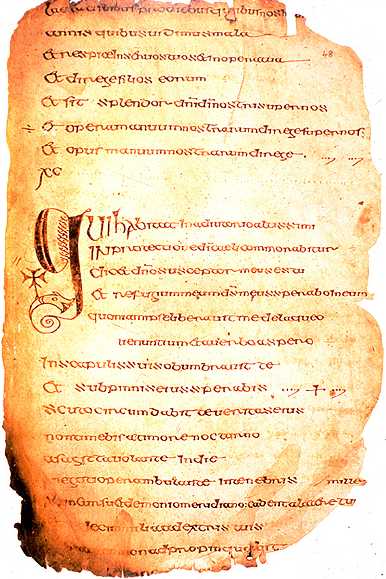 The Cathach of St. Columba is the starting point for Celtic manuscripts. The traditional story is that Columba was lent a psalter by St. Finnian on the condition that he not copy it. Columba nevertheless copied in a single miraculous all-night session. When Finnian discovered the manuscript, he appealed to the local king, who awarded the copy to Finnian. Columba raised his kinsmen which resulted in the Battle of Cúl Dreimhne. Columba went into exile, where he founded Iona, as penance for the men killed in the battle. The Cathach is traditionally identified with Columba's copy. The Cathach, however, has been dated to the 7th century on paleological grounds. Throughout the Middle Ages it was carried into battle as a talisman, a practice from which it gets it name. "Cathach" means "battler" in Irish.
The Cathach of St. Columba is the starting point for Celtic manuscripts. The traditional story is that Columba was lent a psalter by St. Finnian on the condition that he not copy it. Columba nevertheless copied in a single miraculous all-night session. When Finnian discovered the manuscript, he appealed to the local king, who awarded the copy to Finnian. Columba raised his kinsmen which resulted in the Battle of Cúl Dreimhne. Columba went into exile, where he founded Iona, as penance for the men killed in the battle. The Cathach is traditionally identified with Columba's copy. The Cathach, however, has been dated to the 7th century on paleological grounds. Throughout the Middle Ages it was carried into battle as a talisman, a practice from which it gets it name. "Cathach" means "battler" in Irish.The decoration in the Cathach is limited to the first few letters of each Psalm. This decoration establishes several themes that are explored in great depth in later manuscripts. The first letter of each Psalm is enlarged. In earlier manuscripts initial letters had been enlarged and decorated. Bit the decorations in those manuscripts were used to fill space or were appended to the latter. In the Cathach, the decoration distorts the shape of the letter, so that the letter becomes the decoration. Subsequent letters were drawn into the decoration through the gradual shrinking of the letters. In earlier manuscripts the letters after the first letter were the same size as the he rest of the text. In the Cathach, each subsequent letter is a bit smaller than the preceding letter until the letters reach the size of the bulk of the text. The letters are often decorated with small red dots. These three ideas the distortion of letters for decoration, the dimidation of letters, and the use red dots for decoration are ideas worked out in great detail later.

No comments:
Post a Comment